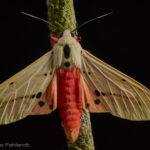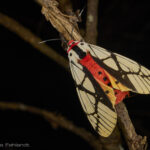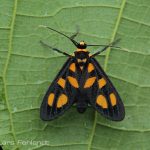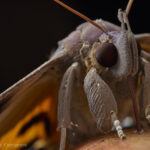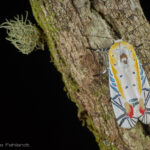Amerila astreus (Drury, 1773) – Sarawak / Borneo – around 1030m ASL
Amerila is an Old World genus of Arctiinae (Erebidae) and the sole member of the tribe Amerilini; it was erected by Walker in 1855 (type species Sphinx astreus Drury, 1773), and no secure etymology of the name has been published. With roughly 90 described species, diversity peaks in the Afrotropics (including Madagascar), with further occurrences across the Oriental to Australasian regions (South and Southeast Asia, New Guinea, Australia). Many species display hyaline wing patches and brightly colored abdomens, and reliable identification usually requires examination of the genitalia. Larvae are polyphagous on numerous angiosperm families, including Smilacaceae (Smilax), Apocynaceae (Marsdenia, Beaumontia), Rubiaceae (Ixora), Dioscoreaceae (Dioscorea), and in Africa additionally Euphorbiaceae (Bridelia, Croton), Fabaceae (Erythrina), Moraceae (Ficus), Musaceae (Musa), and Solanaceae (Solanum). Pupation in several species occurs near the ground in a cocoon incorporating soil particles; life-history details are particularly well documented for A. astreus. Adults especially males exhibit pronounced pharmacophagy on pyrrolizidine-alkaloid plants (e.g., Heliotropium), using the sequestered alkaloids in courtship and chemical defense, as is typical for many arctiines.
